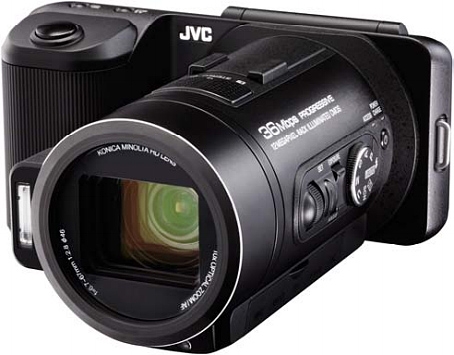The JVC GC-PX10 is officially slated for release this month in the US. The PX10 is very similar to the PX1 we saw earlier this year at CES 2011.
The GC-PX10 features a 12.75MP back-illuminated CMOS sensor and captures 1080/60p video at a 36Mbps sample rate. The 10x zoom lens covers an equivalent focal range of 43.3-433mm when shooting video and 37.4-374mm when shoots stills.
The body style lends to its intended hybrid use of capturing both video and stills. Prosumer camcorder users will find the location of the mode dial, exposure and focus controls in a familiar location on the left side of the body. A traditional shutter release for stills is found on a grip on the right side.
In addition to the HD video capture at 60p, the GC-PX10 captures high-speed video at 300fps, albeit in a lowly standard-def/VGA resolution.
The PX10 will carry an initial retail price of $899.95. Check availability at B&H Photo.
JVC GC-PX10 Press Release
WAYNE, NJ, October 3, 2011 – JVC today announced a new digital camera that uses a new high speed imaging engine to shoot both high quality digital still images and stunning Full HD video. The JVC GC-PX10 is a true hybrid camera that shoots 12 megapixel stills and Full HD 1920 x 1080/60p video. In addition, it offers such professional-level capabilities as 60 shots per second still image shooting, 300 frames-per-second video recording for high-quality super-slow motion and the ability to capture pristine still images from video.
At the heart of the GC-PX10 is JVC’s new FALCONBRID high speed imaging engine, first seen in JVC’s Full HD 3D camcorder, the GS-TD1. FALCONBRID is a single-chip technology with the processing power to allow the GC-PX10 to record Full HD progressive video at 36Mbps for rich, detailed images. In addition, the camera can shoot 8.3 megapixel stills while recording Full HD video for clear, high-quality still images from recorded video. The camera’s image sensor is a 1/2.3” 12.75 megapixel back-Illuminated CMOS sensor.
Digital still shooting in real time offers up to 12 megapixel resolution (4000 x 3000). An ISO6400 mode is available for increased sensitivity when shooting in dark environments. Rapid-fire still shooting of 8.3 megapixel (3840 x 2160) stills is possible at 60 shots-per-second, up to 130 shots total per burst, or 12 megapixel stills at 30 frames-per-second. This surpasses the capabilities of digital SLR cameras currently available.
For super-slow motion shooting, the GC-PX10 can shoot video at 300 frames-per-second. Image resolution is VGA (640 x 360), making it more than sufficient for online posting and viewing. But more importantly, this mode can be used for approximately two hours straight. So, to offer an extreme example, it’s possible to record an entire soccer game in super-slow motion.
Other features that will appeal to the serious shooter include optical image stabilization with JVC’s Advanced Image Stabilizer, 10X optical zoom (19x Dynamic Zoom with no image degradation when zoomed), KONICA MINOLTA HD LENS, a mode dial for both automatic and manual settings (white balance, aperture and shutter), microphone output and headphone input.
The camera offers 32GB of internal memory, SDXC/SDHC card slot, tiltable three-inch touch panel monitor, HDMI output and bundled LoiLoScope FX software for Windows®.
The JVC GC-PX10 will be available this month for $899.95.



There is nothing here indicating the type of audio recorded and the codec used. Does this record in stereo?
I haven’t seen a full spec sheet; however, it does have L and R mic holes on the top of the lens. You can get a better look at those if you hit the link above to the GC-PX1, which is nearly the same camera.
Not sure about the codec. The only thing I’ve seen about that was a reference sheet for the Falconbrid processor at CES, which indicated H.264 for the high-speed 300fps at VGA quality (again, see the PX1 link). However, most of the recent consumer-grade 1080/60p cameras have been AVCHD 2.0 for the 60p stuff (even if there are other codecs used at different frame and bit rates).
Thanks Eric. I found a PX 1 pic. The stereo mic is on the top of the lens with left and right holes. The audio codec is aac. It is hard to see that with this photograph. On the B and H site, this PX10 claims to have a mic input too. That can be an advantage if one has a better stereo mic on hand then the one built into the camera.
The reason why I advocate stereo is that some microphone systems are more omnidirectional on their polar fields. When this occurs, one can run the audio through a home theater receiver that has a virtual mode and/or some 5.1 matrix codec like Dolby Pro-Logic 2 movie. It is possible to have matrix surround sound and as such those circuits will let you know that. If one hooks up a passive surround system particulaly Dynaquad, this can be very effective in reproducing matrix surround as well. So what one may have here is an unknown bonus if they try to explore it in the world of camera sound.
I did alot of video photography during the mid 80s to the early 90s using portable vhs linear and hi-fi recorders in the field with a 20 dollar Radio Shack stereo microphone with rather outstanding audio results. It is so much more convenient to handle one camera that does better than the eqipment I used back then. What I am surprised is none of these cameras offer recording in Dolby Digital 5.1 descrete sound. I have a friend who bought a Sony mini dvd camcorder that recorded in this format with phenomenal results or in other words as good as one would hear with a 5.1 movie from a dvd with the addition of center back surround imaging mimicking a terrific EX channel.
It looks a lot like the older Sony 505, 707, 80? series ….